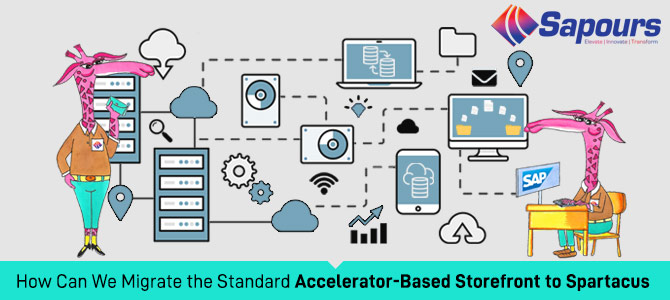For long, customers have loved the impact that custom storefronts made on SAP Commerce Cloud. From enabling rapid personalization to intuitive and hassle-free navigational experience, storefronts have helped businesses transform their online retail experiences. However, the days of JSP-based templates provided by Accelerator storefronts are soon coming to an end.
By the 3rd quarter of 2023, Accelerator UIs are expected to be deprecated by SAP. But there isn’t a need to panic because businesses that leverage Accelerator-based storefronts can move to Spartacus.
What Is Spartacus?
In simple terms, it is a JavaScript-based storefront that can help run an online store without being coupled to SAP Commerce Cloud. Businesses can leverage Spartacus to run a truly headless commerce portal and, in the process, transition into a progressive web app that can be served by SAP Commerce Cloud in the backend as and when needed. It was developed by SAP and is constantly being evolved, with new features added regularly to transform it into the ultimate commerce front-end.
However, to get the most benefits from Spartacus, it is recommended that you upgrade to the latest version of SAP Commerce Cloud and upgrade the web services to OCC Version 2.
How Can Businesses Migrate from Accelerator to Spartacus?
Now that you know what Spartacus is, it is time to learn how to migrate your existing Accelerator-based storefronts to Spartacus. Let us explore the steps:
Build an Inventory of Components
Any migration exercise needs a checklist of items that need a home. The situation is the same for migrating to Spartacus as well. As a business, it is imperative to build a complete inventory of elements on your existing storefront page. It will comprise not just the component but also the data that the component should display in real use, as well as internal controllers. This is applicable not just to standard storefront components but also to the custom components that may have been developed over the years as part of experience modernization initiatives.
It is critical to ensure that no vital component or internal controller is missed out in the migration as it can lead to disruptive end-user experiences – either immediately or in due course of time. Imagine the case of your online store becoming faulty during excessive traffic amid the holiday shopping season. Such events must be prevented at all costs.
Check for OCC Matches for Each Component
It is natural for certain custom components not to have a similar replicable OCC match in Spartacus. But in a migration exercise to Spartacus, enterprises cannot risk missing out on the match for too long. Hence, it is important to first identify and map components to their respective matches in OCC.
For those components that do not find a suitable API in the OCC that supplies the required data or custom service, migration teams must prepare a detailed priority roadmap for custom extension development. Those components which have critical needs in the overall storefront experience must have higher priority for a custom extension development to support their operations.
For example, if the missing OCC service is that of a finance or payment processing option that lets customers choose their desired payment credentials, then a custom OCC extension to facilitate the same must be developed on priority.
Create the Missing Matches
Once the gap in component matches to the OCC are identified, they must be filled quickly and on the defined priority basis. In most cases, businesses would be running their online store parallelly when the migration exercise is being carried out. Hence, it is impossible to shut down any services due to delays in missing API extensions. This is where prioritization takes center stage.
The missing matches must be developed at the earliest to ensure that the migration exercise is successful.
Implement the CMS Pages
The front-end team can start building the user interface once all missing matches are covered by new extensions. They can build front-end components in parallel, while interfaces to OCC extensions are defined based on how they operated earlier. The migration team can leverage any base web content management system (CMS) to replicate the storefront and launch the application with Spartacus.
Missing angular components in Spartacus can be identified from warnings in the browser inspection or developer console. The teams can proceed with building their custom angular components with inherent business logic and complete the implementation of CMS. This is the final stage of the migration exercise.
In a Nutshell
The migration to Spartacus is a challenging endeavor, but given the benefits of moving from the deprecated accelerator components, the effort is worth it. What businesses need is a well-laid out and clearly defined roadmap to migration that covers all the best practices we covered here. Having such a clear progression roadmap is possible only if you have extensive knowledge and expertise with Salesforce OCC and Spartacus.
This is where a technology partner like Sapours can be the best asset for your e-commerce aspirations. Get in touch with us to explore the possibilities of leveraging Spartacus storefronts in your e-commerce websites.

